Research on the Cultivation of the Innovative Subcenters in Sichuan Based on the Chengdu-Chongqing Economic Circle Strategic Background
Zhang Jing and Li Jing
Science and Technology for Development Research Center of Sichuan Province
Abstract: This paper summarizes the development experience of the subcenters in leading provinces, including their establishment mode, strategic positioning, development mode and economic development. It also analyzes the economic development characteristics, regional patterns,and location distributions of Mianyang, Deyang, Leshan, Yibin,Luzhou, Nanchong and Dazhou, the seven alternative subcenters in Sichuan province. It focuses on the analysis of their basic situations regarding scientific and technological (S&T) innovation development including investment in S&T innovation, talent team construction, S&T achievements, industrial structure and S&T platforms compared with the innovative subcenters in leading provinces. Results show that the scale of S&T innovation activities in the seven alternative subcenters in Sichuan province needs to be improved. Finally, based on the Chengdu-Chongqing economic circle strategy, this paper puts forward the thoughts and suggestions on how to cultivate the innovative subcenters in Sichuan province.
Keywords: subcenters, S&T innovation, Chengdu-Chongqing economic circle,innovative subcenters
At the beginning of 2020, the Chengdu-Chongqing economic circle strategy became a national strategy to promote China’s major regional development. In July, the Seventh Plenary Session of the 11th CPC Sichuan Provincial Committee examined and approved the “Decision of the CPC Sichuan Provincial Committee on Further Implementing the Guiding Principles from General Secretary Xi Jinping’s Major Speeches and Accelerating the Development of Chengdu-Chongqing Economic Circle.” They put forward a view to strengthen the secondary support of the Chengdu-Chongqing economic circle and to support the regional central cities to become sub-economic centers within Sichuan province and the Chengdu-Chongqing region. The cultivation of the subcenters in Sichuan province has become an important deployment in support of the national strategy to build the subcenter in the Chengdu-Chongqing economic zone.
The Origin and Connotations of Subcenters
Theoretical Origin
The concept of provincial centers was first proposed by Qin Zunwen, a researcher of Hubei Academy of Social Sciences, who carried out the strategic layout of “one main city and two secondary cities” according to the characteristics of the unbalanced economic development of the east and the west in Hubei province (Qin, 2011). Later, it developed as the provincial subcenters theory. At present, China has 50 provincial subcenters distributed throughout Guangdong province, Jiangsu province, Zhejiang province and 26 other provinces(or cities).
Strategic Connotation
The strategic connotation of provincial subcenters’ cultivation is to redirect Chinese economic development mode transitions. The original intention to cultivate provincial subcenters is to optimize the layout of regional economic development and promote surrounding areas. However, as China’s economy is now in a transitional period from “rapid growth” to “high-quality development,” development must also shift to an innovation-driven mode. In addition, China has entered the advanced stage of industrialization, and S&T innovation’s contribution to economic growth is rapidly increasing. Therefore, for provincial subcenter cities, it should strengthen scientific and technological innovation to promote highquality development.
The Practice of Subcenters in Leading Provinces
Provincial subcenters are usually more than 150 kilometers away from the provincial capital city. They have stronger comprehensive strength than the surrounding areas, larger radiation-driven capability for perimeters, and unique superior resources. Generally, they are usually “prefecture-level cities” according to the administrative levels.
Approaches to the Establishment of Subcenters
There are three main approaches to the establishment of subcenters. First, the cities specifically designated in the state plan become subcenter, such as Dalian in Liaoning province, Qingdao in Shandong province, Ningbo in Zhejiang province, Xiamen in Fujian province and Shenzhen in Guangdong province. Second, the cities with unique advantages become subcenters, such as Luoyang in Henan province, Sanya in Hainan province,Guilin in Guangxi province, Quanzhou in Fujian province, Zunyi in Guizhou province,Yantai in Shandong province, and Suzhou and Wuxi in Jiangsu province. Third, the CPC provincial committees and governments directly set up subcenters, such as Xiangyang and Yichang in Hubei province, Ganzhou, Jiujiang and Shangrao in Jiangxi province,Wuhu in Anhui province, Datong, Changzhi, Jincheng and Yuncheng in Shanxi province,Yueyang, Hengyang and Changde in Hunan province, and Zhuhai, Shantou and Zhanjiang in Guangdong province.
Strategic Positioning of Subcenters
Subcenters are mainly set up for three purposes.
First, subcenters can be the multi-point and multi-pole in local regions to drive local economic development. Provincial subcenters stimulate the development of surrounding areas, and their primary function is to optimize the regional layout by changing the provincial landscape from “one center” to “multiple centers”. For example, Shenzhen in Guangdong province, Ningbo in Zhejiang province, Suzhou and Wuxi in Jiangsu province, Qingdao in Shandong province, Yantai and Dalian in Liaoning province, have formed a “dual-core” or“three-core” development landscape with central cities in their respective provinces, jointly promoting provincial prosperity.
Second, subcenters can contribute to reducing the overload burden of central cities. The central cities usually gather manifold functions concerning provincial government, economy,culture and communications, which cause overcrowding and excessive expansion. The subcenters can take some functions of the central cities’ and effectively alleviate the “big city disease.” For example, Xiangyang, a subcenter in Hubei province, as a regional center adjacent to Hubei-Henan-Chongqing-Shaanxi, shares part of the transportation hub functions with Wuhan, the central city. Similarly, Hengyang shares the southern Hunan area’s political,economic, military, cultural-center and transportation hub functions.
Third, subcenters can remedy the functional deficiencies of the central cities. Due to regional and historical conditions, some central cities have restrictions on certain functions,so subcenters can be a better choice to cover the shortages. Shenzhen, the subcenter in Guangdong province, is the financial center and S&T innovation center. Suzhou, the subcenter in Jiangsu province, is the economic center. Dalian, the subcenter in Liaoning province, is a shipping and foreign trade center. Xiamen, the subcenter in Fujian province, is the center of tourism, foreign trade, and shipping. These functions supplement and support the strengths of their central cities.
Innovation-driven Development of Subcenters
As China’s economy has shifted from rapid growth to high-quality development, many subcenters have embarked on the road of innovation-driven development. Since 2008,Ministry of Science and Technology of the People’s Republic of China and the National Development and Reform Commission have implemented innovative city pilot projects to encourage qualified cities to try the innovation-driven mode. These cities usually have good innovation foundations, outstanding advantages and characteristics, and obvious regional radiation effects as well. Now 78 cities are developing as national pilot cities for innovative development, including 18 provincial subcenters, which account for nearly 40 percent of the total number of subcenters. All the subcenters that are developing in Jiangsu province, Fujian province, Shandong province, Liaoning province and other 10 provinces are innovative cities.These cities are identified as innovative subcenters in this paper.
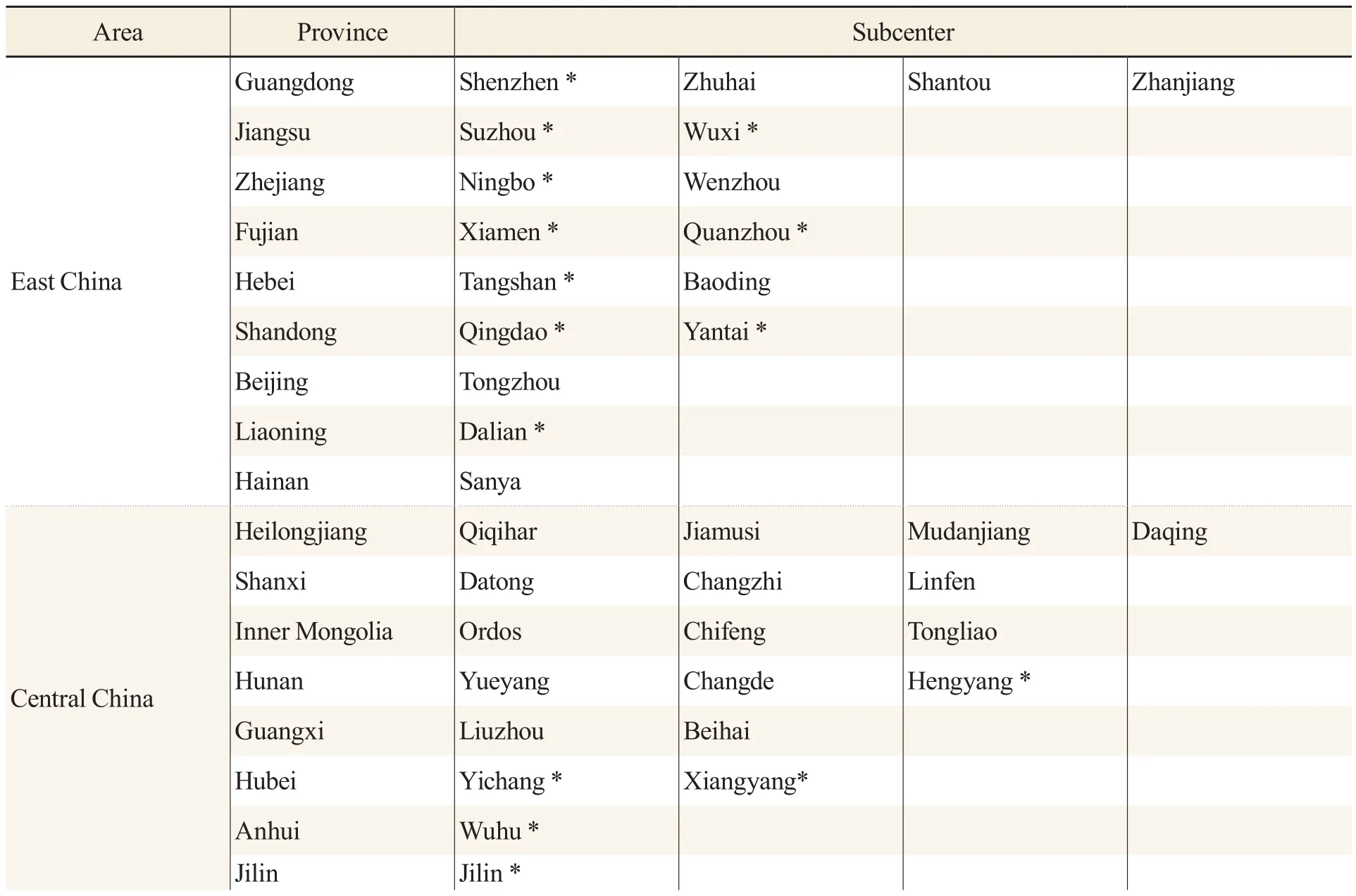
Table 1 (Innovative) Subcenters

Note: * represents an innovative subcenter city
The Economic Development of Innovative Subcenters
The innovative subcenters have significant advantages. There is a correlation and interaction between S&T innovation and economic performance. Both as innovative cities and subcenters, the innovative subcenters’ economic performance is much better than that of the non-innovative subcenters (see Table 2). Generally, the average GDP of innovative subcenters was RMB656.46 billion higher than that of non-innovative subcenters, with a ratio of 4.5 times. After excluding the cities specifically designated in the state plan, the ratio was 3.8 times and the gap was still obvious. In different regions, economic disparities between innovative cities and non-innovative cities were the biggest in eastern China, with the average GDP ratio 3.5 for the two kinds of cities. The ratio was 3.0 in central China and 2.6 in western China in which the difference was relatively flat. For non-innovative subcenters,their local economic growth was mainly due to fixed asset investments, local resources and traditional industries.

Table 2 Average GDP of (Non-) Innovative Subcenters
Generally, the economic development level of central cities is relatively higher that of subcenters. Based on the data of 18 innovative subcenters in 2018, the central cities’average proportion of GDP in their province was 24.5 percent, while the subcenters was 15.5 percent. In eastern China, the subcenters’ contribution to provincial economies was no less than that of the central cities. Six subcenters, namely, Tangshan in Hebei province, Suzhou in Jiangsu province, Quanzhou in Fujian province, Qingdao in Shandong province, Shenzhen in Guangdong province, and Dalian in Liaoning province, made greater contributions to the local economy than provincial central cities did. Furthermore, the average proportion of provincial GDP in the provinces of Suzhou, Qingdao and Dalian were at least 5 percent higher than that of their central cities. In central and western China, the economic performance of subcenters was obviously inferior to that of central cities. The subcenters generally had a low contribution to the regional economy. Except for Zunyi in Guizhou province, the GDP of other cities accounted for lower than 11 percent of the province. In addition, the pattern of “one dominant city” led to a big gap in local GDP contributions to the provinces between subcenters and central cities.The largest gap was between Jilin city, the subcenter, and Changchun, the central city in Jilin province where the GDP contribution of Jilin city to the province was 37.6 percent points lower than than Changchun. Meanwhile the gap between Yichang and Xiangyang in Hubei province,Baoji in Shaanxi province and Hengyang in Hunan province and their central cities were all higher than 21 percentage points.
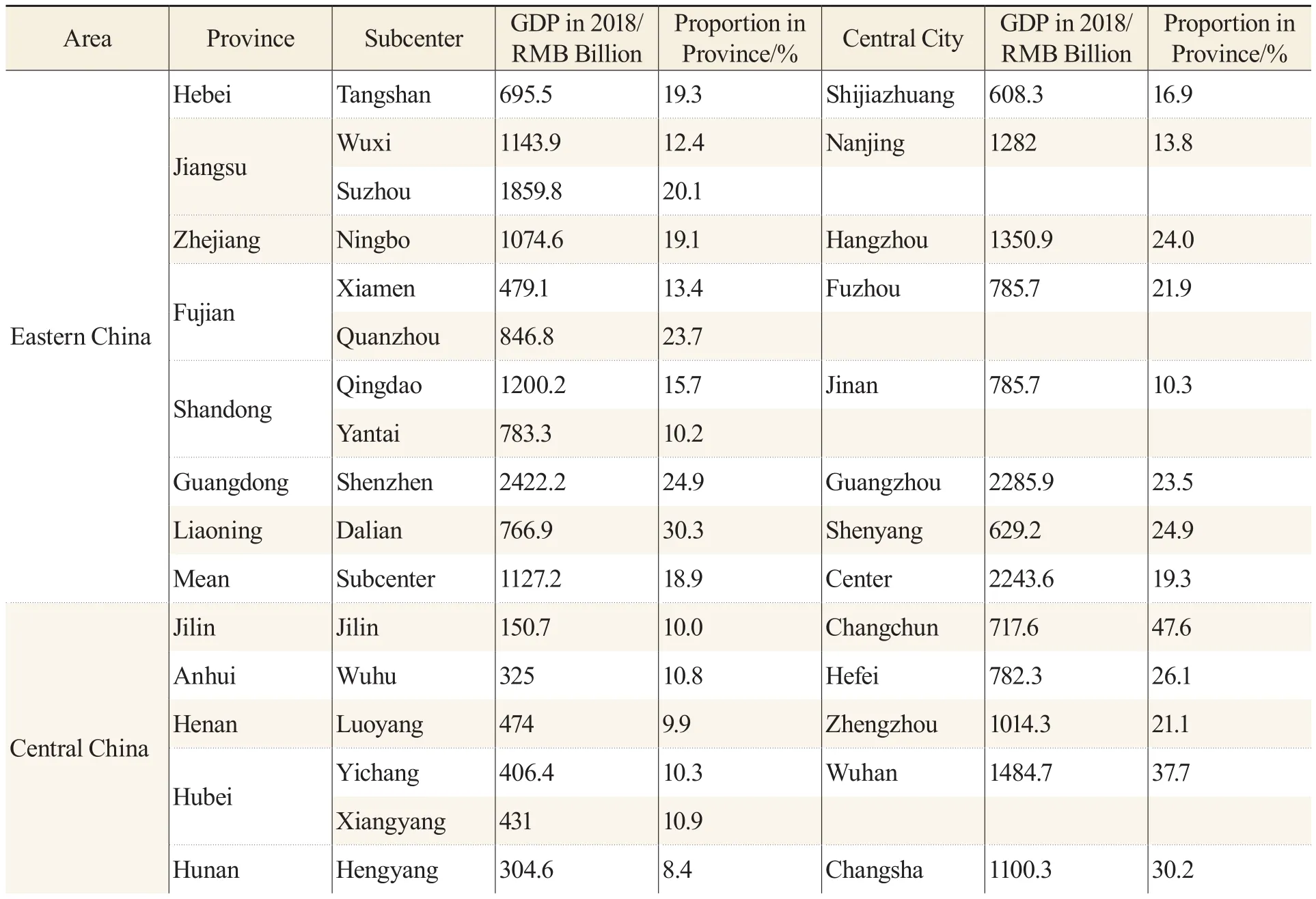
Table 3 Economic Development of Innovative Subcenters

Source: Local government bulletin in 2018
Development of Seven Alternative Subcenter Cities in Sichuan Province
In 2018, the Third Plenary Session of the 11th CPC Sichuan Provincial Committee proposed to develop Mianyang, Deyang, Leshan, Yibin, Luzhou, Nanchong and Dazhou as regional central cities to cultivate provincial subcenters in Sichuan province. Among these cities, Deyang, Yibin and Luzhou are the first batch of provincial innovative cities under construction. In 2020, the Chengdu-Chongqing economic circle became a national strategy and the Seventh Plenary Session of the 11th CPC Sichuan Provincial Committee plans to take regional central cities’ cultivation and expansion as a strategic project to realize the Chengdu-Chongqing central area development and the south wing crossing and north wing revitalization. The Chengdu-Chongqing central area development will be driven by Mianyang, Deyang and Leshan, cities that can accelerate the integrative development of the Chengdu Plain economic zone. The key to the south wing crossing is that Yibin and Luzhou can strengthen the coordinated development of Sichuan and Chongqing along the Yangtze River and vigorously promote the integration of inner cities and southern Sichuan. The main point of the north wing revitalization is that Nanchong and Dazhou need to actively undertake the industrial transfer of Chengdu and Chongqing to accelerate the development of the northeast Sichuan economic zone. The seven alternative cities, Mianyang, Deyang,Leshan, Yibin, Luzhou, Nanchong and Dazhou will be given more important strategic development missions.
Characteristics of Economic Development
Economic development and S&T innovation in Sichuan province present a regional pattern of “one dominant city”. Chengdu is not only the economic and innovation center of Sichuan province, but also the core of the Chengdu-Chongqing economic circle. In 2019,Chengdu’s GDP reached RMB1.7 trillion, accounting for 36.5 percent of the provincial total and 24.2 percent of the Sichuan-Chongqing region. Mianyang, Deyang, Yibin, Nanchong,Luzhou, Dazhou and Leshan, the seven cities, which are striving to become subcenters,have ranked 2nd to 8th by GDP in the province for four consecutive years. But each regional GDP accounted for less than 6 percent of Sichuan province, and their economic aggregate accounted for only 33.3 percent of the province, which was still less than Chengdu. Meanwhile, the seven cities’ investments in innovation showed an obvious echelon distribution.
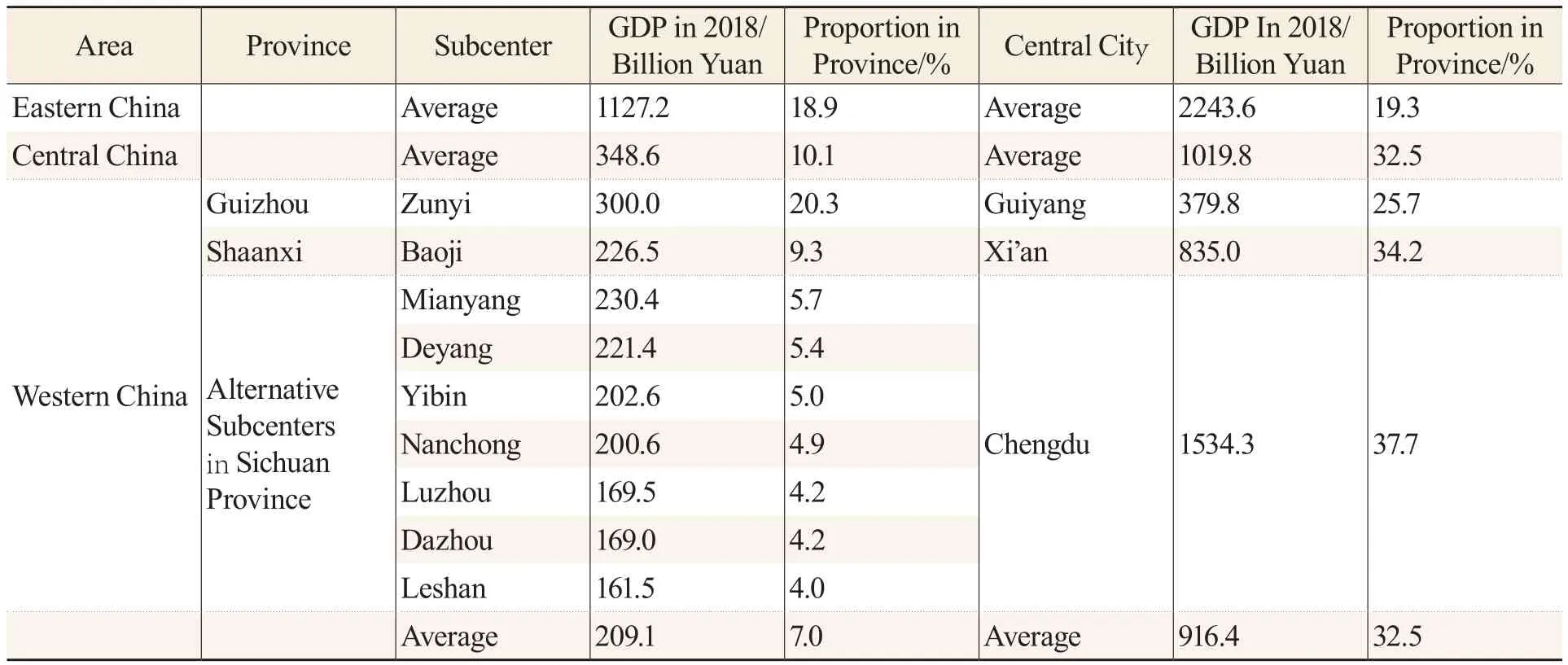
Table 4 Economic Development
There is a big economic gap between the seven cities in Sichuan province and the innovative subcenters in other leading provinces. GDP in each of Sichuan’s seven alternative subcenters was less than 1/3 of the average GDP of innovative subcenters in the leading province, and also less than that in the western region. The GDP of Mianyang, the city with the highest GDP among the alternative subcenters, was only 20 percent of the average GDP of innovative subcenters in the eastern region. The contribution of Sichuan’s seven cities to the provincial economic development was small. The GDP proportion of each of the seven cities was less than six percent, which was far from the average of innovative subcenters in the leading provinces (15.5 percent).
Regional Pattern and Location Distribution
In developed eastern provinces, the central cities and subcenters are equally important for development, while Chengdu, the central city, is the only dominant city in Sichuan province.Chengdu undertakes too many functions and plays an irreplaceable role in economic growth and innovation of Sichuan province. This pattern is similar to Zhengzhou in Henan province,Changsha in Hunan province and Wuhan in Hubei province. Because various economic and S&T innovation elements are highly concentrated in Chengdu, it intensifies the unbalance of regional development in the province. However, most developed provinces present a“dual-core” or “tri-core” regional pattern. Central and subcenters are economically active,with strong and expanding development momentum in Hangzhou and Ningbo in Zhejiang province, Nanjing, Suzhou and Wuxi in Jiangsu province, and Jinan, Qingdao and Yantai in Shandong province.
The distance between provincial subcenters and central cities needs to be moderate. In leading provinces, the average distance between innovative subcenters and central cities is 230 kilometers. It is 266 kilometers in the eastern region, 196 kilometers in the central region and 158 kilometers in the western region. In Sichuan province, Chengdu, Deyang and Mianyang have formed a trend of cohesive development. Mianyang, Deyang and Leshan are the central cities of the integrated development of the Chengdu Plain economic zone and they are located near Chengdu, about 74 to 135 kilometers away. Yibin and Luzhou are important cities in the urban agglomeration of southern Sichuan economic zone. They are also the central cities in the Chengdu-Chongqing economic circle that comprise “the south wing” span and the main node cities of the Chengdu-Chongqing principal axis. They are both more than 250 kilometers away from Chengdu, and have relatively good economic and innovative development. Nanchong and Dazhou are the “two cores” of the urban agglomeration in northeastern Sichuan and are the central cities that lead revitalization of “the north wing” in the Chengdu-Chongqing economic circle. They are more than 230 kilometers and 400 kilometers respectively away from Chengdu. From the perspective of this regional layout, cultivating subcenters in southern Sichuan economic zone and northeastern Sichuan economic zone are likely to form a triangular pole with Chengdu, which will promote the provincial development and stimulate the development of the surrounding areas.
The Science and Technology Innovation Development Foundations of Sichuan Alternative Subcenters
R&D Investment
In 2018, Chengdu invested RMB39.23 billion in R&D activities, accounting for 53.2 percent of the provincial total. Mianyang invested RMB15.24 billion, accounting for 20.7 percent of the provincial total. Deyang and Yibin invested RMB5.73 billion and RMB2.44 billion respectively, their aggregate accounting for 11.1 percent of the provincial total. The R&D investments of the remaining four cities were less than RMB2 billion, accounting for 6.0 percent of the provincial total. Mianyang and Deyang benefited from the S&T support given by the national central government to research institutions in Sichuan, so the R&D intensity reached 6.61 percent and 2.59 percent, both higher than Chengdu. Mianyang’s R&D intensity was even the highest among all the innovative cities, and Deyang’s R&D intensity surpassed 80 percent of innovative cities nationally. The R&D intensity of Yibin was 1.21 percent, only better than 20 percent of innovative cities nationwide. However, R&D intensity in Nanchong,Luzhou, Dazhou and Leshan was all less than 1 percent.
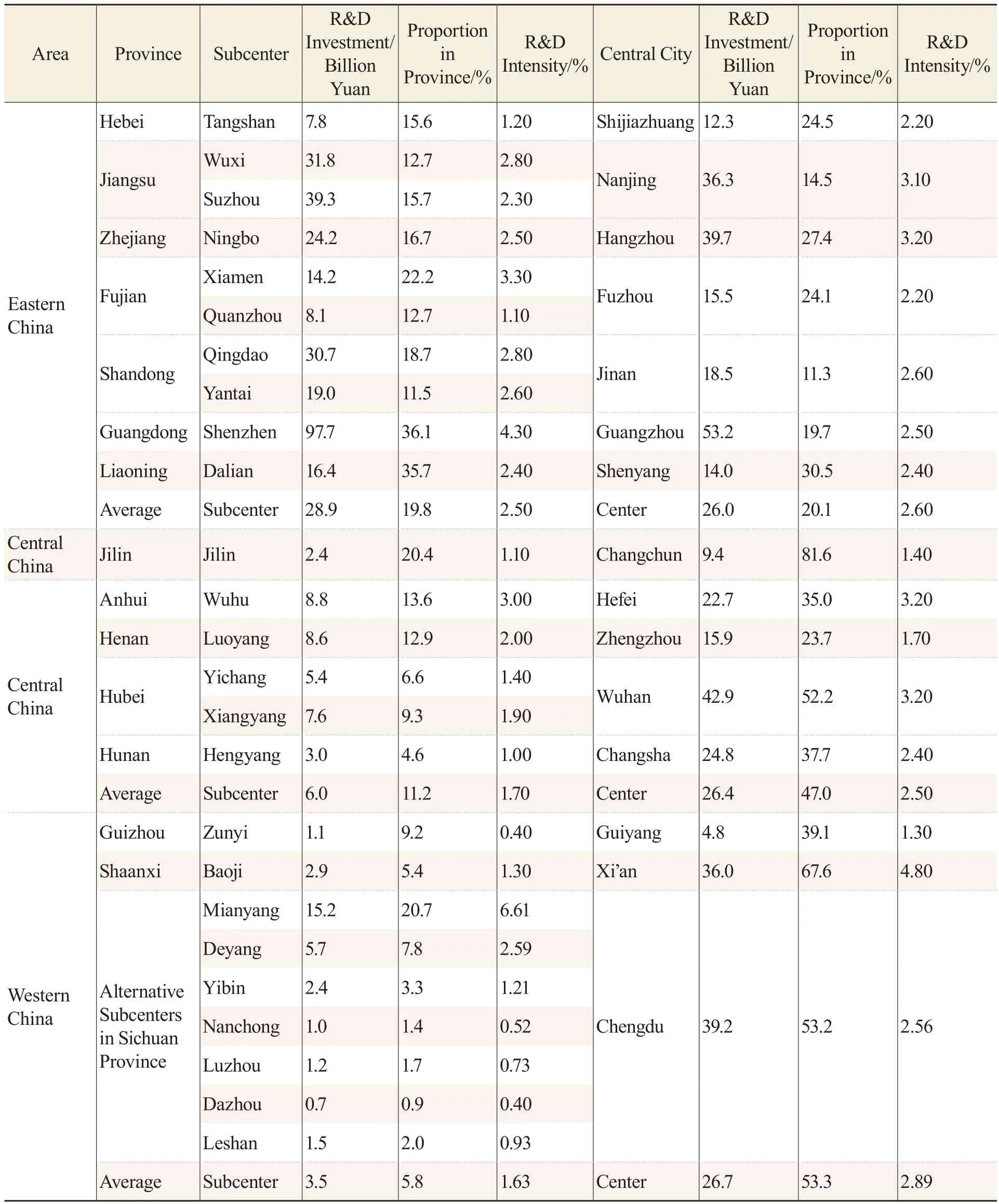
Table 5 R&D Investment
Seven alternative subcenters have their own advantages. In terms of R&D intensity,Mianyang had a prominent advantage. Deyang (2.59 percent) was very close to the average value of innovative subcenters in the eastern provinces (2.50 percent), while the remaining five cities had low R&D investment intensity with little competitiveness. However, each of the seven cities in Sichuan province laid out less R&D investment than the average amount of innovative subcenters in the eastern provinces (RMB28.93 billion).
Innovation of Science and Technology Personnel Teams
R&D personnel is the main component of the S&T innovation personnel teams. Among the alternative cities in Sichuan province, Mianyang invested in 28,480 full-time R&D personnel in 2018, ranking first among the seven alternative cities. Deyang invested in 10,394 full-time R&D personnel, and the remaining 5 cities invested in less than 10,000 full-time personnel, which was far lower than the average of 14,197 full-time people in the central and 63,270 full-time people in eastern innovative subcenters, and greatly different from the 88,810 full-time R&D personnel in Chengdu, the central city of Sichuan province.
The proportion of R&D personnel in every 10,000 employed personnel reflects the intensity of the R&D personnel input. Among the alternative subcenters in Sichuan province,Mianyang had the highest intensity of R&D personnel input (95 persons/year), followed by Yibin (85 persons/year). The average intensity of R&D personnel input in the seven cities was 47 persons/year, 5 persons/year higher than that of the innovative subcenters in the central region and 34 persons/year lower than that of the eastern region. Among them, the intensity of R&D personnel input in Deyang and Yibin exceeded that of some innovative subcenters in the eastern region, which indicates they have a certain competitiveness in S&T innovation.
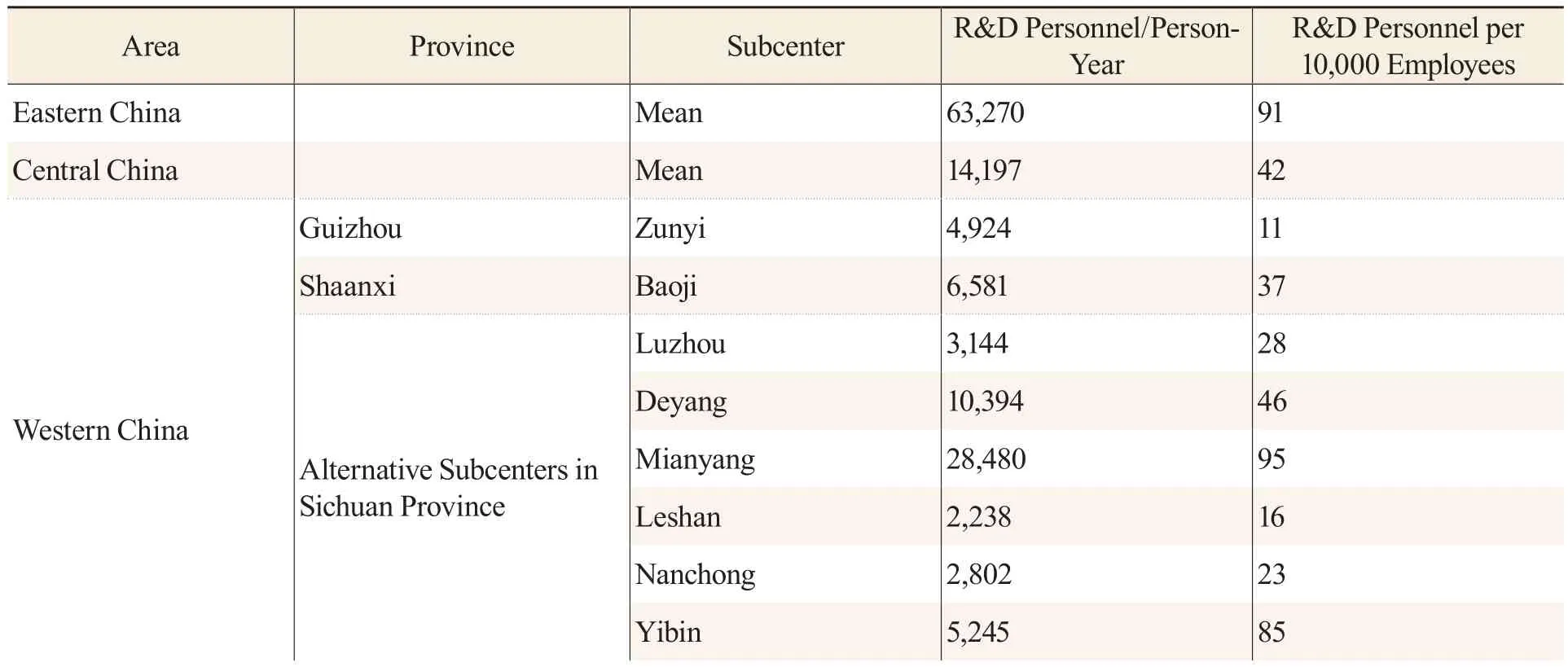
Table 6 Science and Technology Personnel

Area Province Subcenter R&D Personnel/Person-Year R&D Personnel per 10,000 Employees Western China Alternative Subcenters In Sichuan Province Dazhou 1,763 39 Average 7,286 42
Scientific and Technological Innovation Outputs
The ownership of invention patents is a typical index used to measure the output of S&T innovation. Among the candidate cities of Sichuan province, Mianyang had 5,406 valid invention patents. Deyang had 2,682. Yibin had 2,131. The rest of the cities had less than 1,000.Innovation-oriented subcenters in the eastern region had an average of 25,623 valid invention patents, nearly five times that of Mianyang. The number of invention patents owned by 10,000 people reflects the output efficiency of innovation achievements. The number of invention patents owned by 10,000 people in Mianyang was 11.1, and that in Deyang was 7.6. The number of invention patents owned by 10,000 people in other regions was less than 5, while the average number of innovative subcenters in the eastern and central regions was 27.3 and 8.3 respectively.
The technical contract turnover reflects the active degree of the transformation of scientific and technological achievements. Among the alternative subcenters in Sichuan province, the technical contract turnover in Mianyang reached RMB1.22 billion, Luzhou RMB940 million, and Deyang RMB700 million. The remaining areas were less than RMB300 million, which means the transformation of S&T achievements was insufficient.The average technical contract turnover of innovative subcenter cities in the eastern region and central region were RMB11.86 billion and RMB5.02 billion respectively, far more than those in Sichuan province. The proportion of technology contract turnover in GDP reflects the degree of support S&T provides to the local economy. The percentages in Luzhou and Mianyang were 0.55 percent and 0.53 percent, respectively, and 0.32 percent in Deyang. The remaining areas were less than 0.20 percent, while the average technical contract turnover of innovative subcenters in the eastern and central regions were 0.93 percent and 1.35 percent,respectively, whose supporting effects of S&T innovation on the economy was significantly higher than that of the seven cities in Sichuan province.

Table 7 Scientific and Technological Innovation Output

Source: Local government bulletin in 2018
Development of High-tech Industries
The scale of high-tech industries in the seven cities is small but is making a positive contribution to the economy. High-tech industry represents the development of local R&D activity intensity in industry. Among the alternative cities of Sichuan province, there were only 263 high-tech enterprises in Mianyang, 203 in Deyang,111 in Yibin and less than 100 in the other areas, which was lower than the average number of 2,385 and 303 of innovative subcenters in the eastern and central regions respectively. The proportion of the main income of high-tech enterprises is an important index to measure the industrial structure of S&T innovation. The proportion in Mianyang was 50 percent, the highest in the province,followed by Leshan, Dazhou and Deyang, which were 23.5 percent, 21.8 percent and 20.9 percent respectively. The remaining were no more than 15 percent. The average proportion of innovative subcenters in the eastern region and the central region were 30.1 percent and 28.5 percent respectively, which shows that Mianyang had an absolute advantage.

Table 8 High-tech Industries
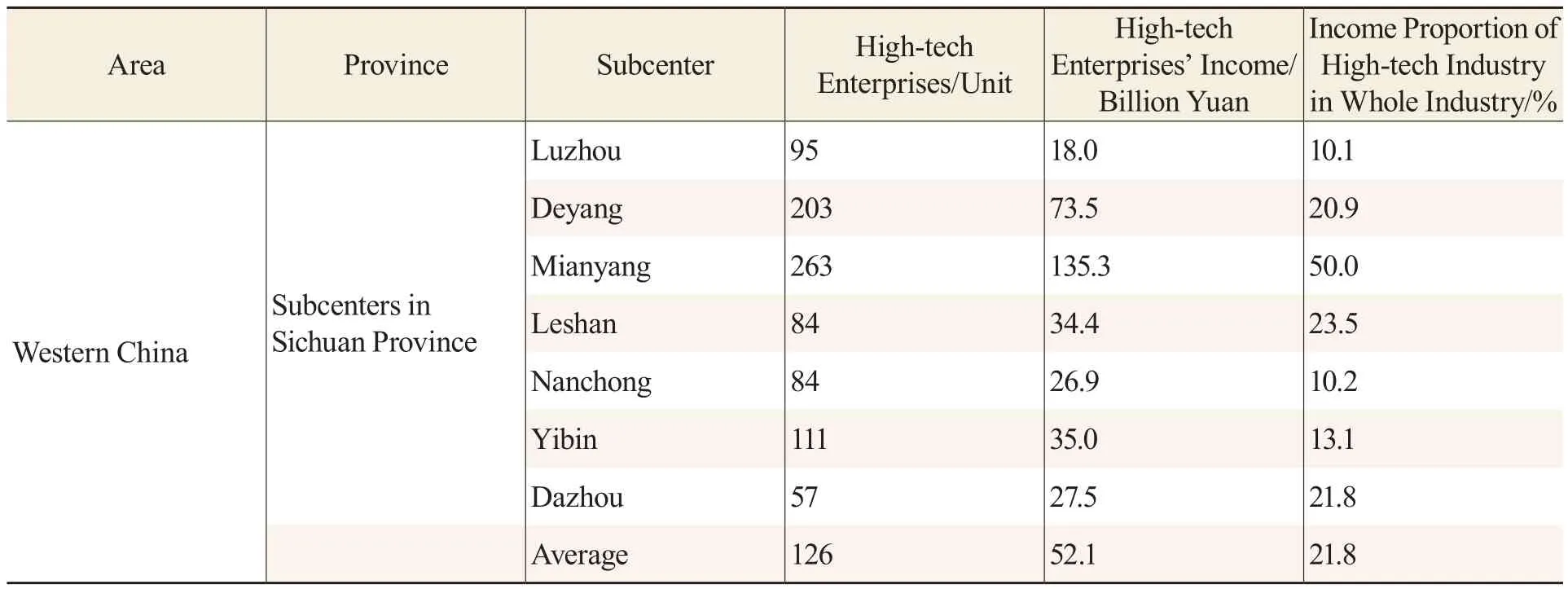
Source: Local government bulletin in 2018
National Science and Technology Platforms
National science and technology platforms are high-quality platforms for S&T innovation,including key state laboratories, engineering technology research centers, S&T business incubators, national university S&T parks, national record space for mass innovation,national demonstration bases for mass entrepreneurship and innovation, and national bases for international S&T cooperation. Among the candidate subcenters in Sichuan province,Mianyang has 20 national science and technology platforms, Luzhou has seven, and the remaining areas have less than five. What is more, there are only two key state laboratories and one engineering technology research center in Mianyang, one key state laboratory in Deyang and one national engineering technology research center in Luzhou. The average number of national platforms in innovative subcenters in the eastern and central regions is 65.5 and 9.7 respectively. The scale of national S&T platforms for the seven alternative subcenters is small.

Table 9 National S&T Platforms

Source: Local government bulletin in 2018
Thoughts and Suggestions on Cultivation of Innovative Subcenters in Sichuan Province
Deeply Integrate Provincial Sub-Center Cultivation with the Layout of the Sub-Pole in the Chengdu-Chongqing Economic Circle
Based on the strategic layout of “one main city and two secondary cities” in the Chengdu-Chongqing economic circle, regarding the development strategy of “one stem and many branches” as the most important support, development should focus on cultivating and integrating the provincial subcenters in Sichuan with the formation of a sub-pole in the Chengdu-Chongqing region in order to promote innovative interactions and factor aggregation capacities in Sichuan and Chongqing. Cultivation and expansion of the subcenters needs to be regarded as an important regional strategic project to support the construction of the Chengdu-Chongqing economic circle. In this way, it will be beneficial to the rise of the central Chengdu-Chongqing region, the qualitative leap of “the south wing”and the revitalization of “the north wing” in the Chengdu-Chongqing economic circle.
Clearly Determine Functional Positioning of Subcenters Within the Chengdu-Chongqing Economic Circle
To enhance the comprehensive ability of the region, including its economy, innovative ability and population carrying capacity, the priority functional positioning of the subcenters needs to share these functions to reduce the degree of centralization of Chengdu. In Chengdu Plain economic zone, Mianyang should be built into China’s S&T city with international influence and to be a national scientific research and production base; Deyang should be developed as a world-class major equipment manufacturing base; Leshan should become“China’s green Silicon Valley” in the photovoltaic industry chain. In southern Sichuan economic zone, Yibin should be mainly cultivated as a national innovative modern industry development demonstration zone and a national demonstration city for industry and education integration; Luzhou should be cultivated as a shipping and trade center in the upper reaches of the Yangtze River and a regional medical and health center which will bring about a qualitative leap for “the south wing”. In northeastern Sichuan economic zone,Nanchong should be built into a central city in the north of the Chengdu-Chongqing area and a demonstration city of the Jialing River green ecological economic zone; Dazhou should be built into a comprehensive transportation hub in the east and the north to accelerate the revitalization of “the north wing.”
Strengthen the Innovation Capacity of Innovative Subcenters
Based on Chengdu S&T City and Mianyang S&T City, the government should actively promote the construction of the Chengdu-Chongqing S&T Innovation Center and strive to establish the first “comprehensive national science center” in western China. Joint efforts should be made to implement the first trial of the national S&T innovation policy in the Chengdu-Chongqing region and endeavor to establish more national major S&T infrastructures, frontier science centers, national laboratories and other national research bases and platforms, and to widely attract S&T resources and talents to Sichuan. The government should improve the carrying capacity of the original innovation, basic research and cutting-edge interdisciplinary fields, the joint research capability of major science and applied technologies, and the pooling capacity of high-end innovation resources. The government should build a multi-tiered system of regional innovation and make regional innovation interconnected in terms of innovation growth poles, growth points and growth belts, actively explore ways to build an innovative system with “province-city-county”linkage development, and accelerate the construction of innovative provinces and innovative cities in Sichuan province.
Provide Sufficient Policy Support to Subcenters
A subcenters cultivation coordinating group should be set up by drawing lessons from the development-coordinating group for the Yangtze River economic belt, the coordinating group for the Belt and Road Initiative construction, and the coordinating group of the Beijing-Tianjin-Hebei association for development. A provincial subcenters cultivation coordinating group should be established to make top-level designs and supervise the development and growth of the subcenters to support the national strategy. The government should grant greater financial and economic and social management rights to subcenters, coordinate benefits between provincial and municipal governments and draw lessons from the subcenters which are specifically designated in the state plan, and the subcenters in Jiangsu province and Zhejiang province. The government should reserve part of the tax revenue for subcenters to develop, grant subcenters certain territorial tax management authority, and delegate provincial-level planning and economic management powers, such as the power of land index planning and tax type adjustments, to subcenters so that they can develop flexibly according to local conditions. Resource allocations should be prioritized to the subcenters. Major production and innovation factors, such as the layout of industrial parks, the construction of large enterprises, and the establishment of colleges and institutional branches, should also be prioritized to subcenters to improve their comprehensive strength and distribute the highly concentrated functions of the central cities.
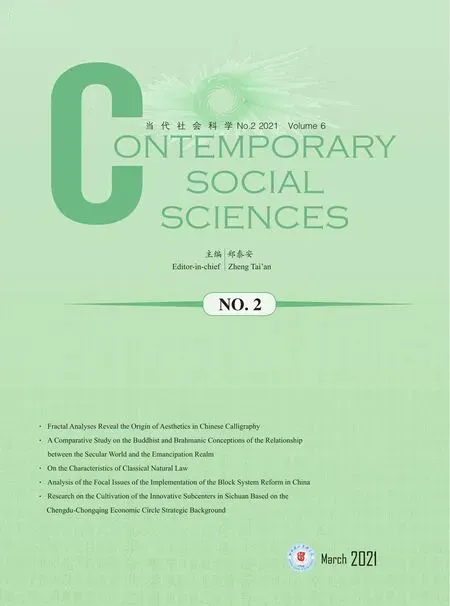 Contemporary Social Sciences2021年2期
Contemporary Social Sciences2021年2期
- Contemporary Social Sciences的其它文章
- The Information Efficiency of QFII’s Investment in China’s Capital Market
- Research on the Realization Mechanism of and Approach to Ecological Product Valuations
- Analysis of the Focal Issues of the Implementation of the Block System Reform in China—From the Perspective of the Protection of Civil Rights
- A Comparative Study on the Buddhist and Brahmanic Conceptions of the Relationship between the Secular World and the Emancipation Realm
- The International Profile of Chinese Visiting Scholars in the UK:Improvement Needed in Linguistic,Cultural, and Academic Confidence
- Fractal Analyses Reveal the Origin of Aesthetics in Chinese Calligraphy
